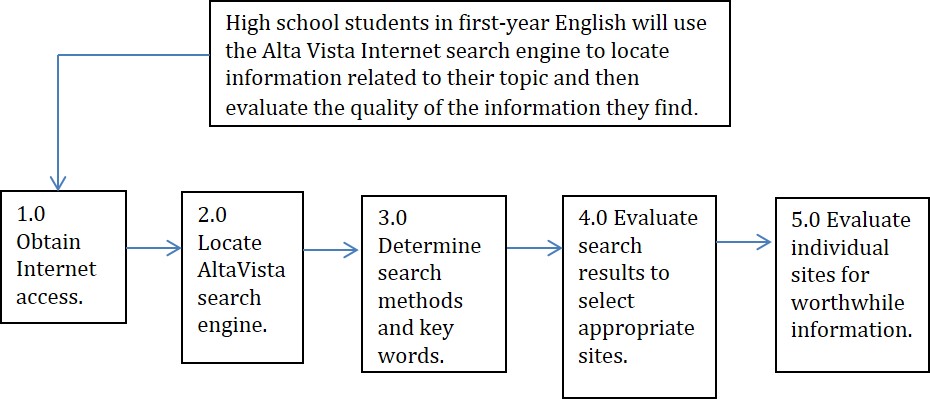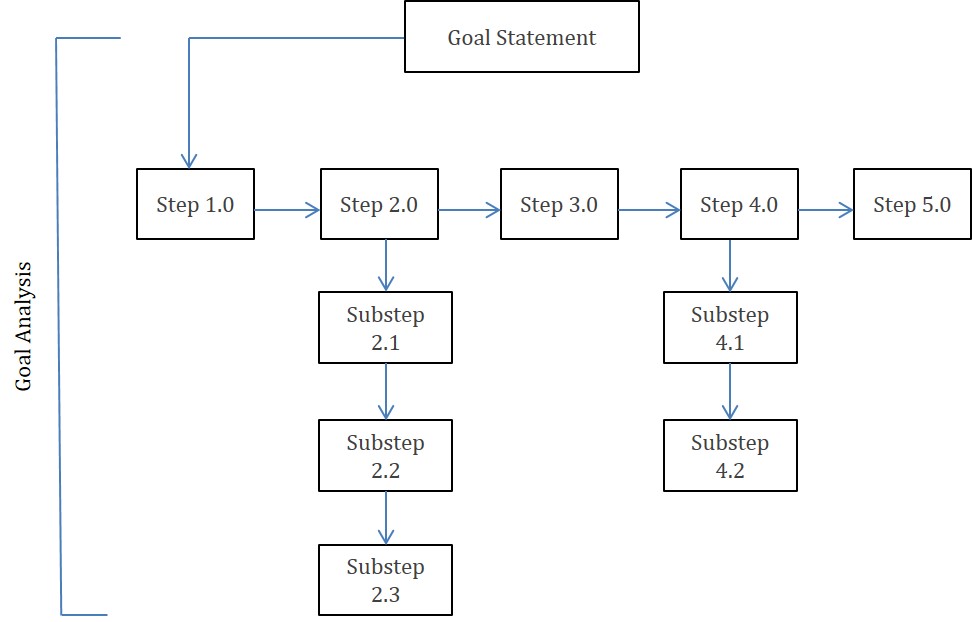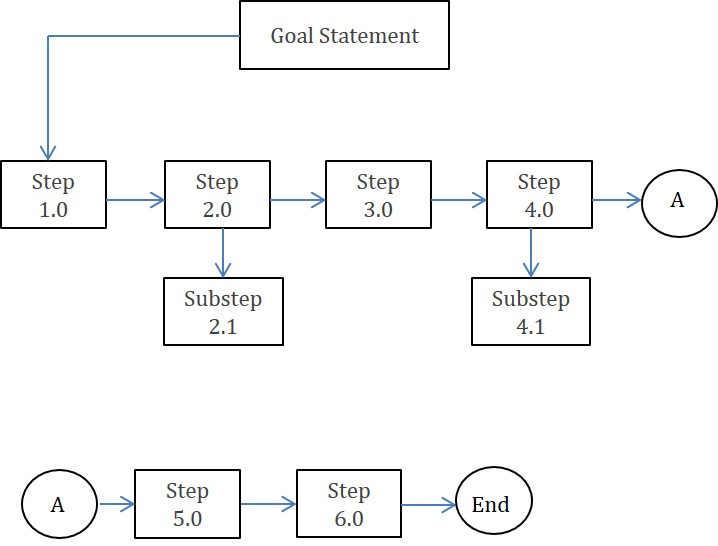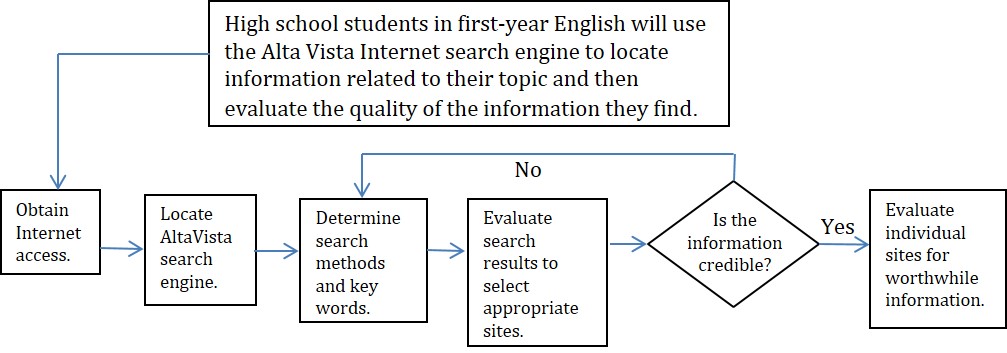Lesson 5: Goal Analysis
Reading
Read Chapter 3, Conducting a Goal Analysis, from Dick, Carey, and Carey
Introduction
Now that you have a description of your learning need and have formulated an appropriate,
feasible, and clearly stated instructional goal your ID Project, it is time to begin conducting the
Instructional Analysis. The Instructional Analysis focuses on the performance environment and
what occurs when one who knows how to perform the goal (e.g., an expert) does so. The
performance environment is a future real-world place where the learners could use the
knowledge and skills gained from the instructional module you will design. Since we want our
learners to gain the skills of an expert, we must analyze what an expert does when he performs
the goal. This will helps us determine what our learners need to learn. However, you are not
analyzing your instruction, therefore the label "Instructional Analysis" can be confusing.
The Instructional Analysis involves two steps – the goal analysis and the subordinate skills
analysis. The lesson discusses the goal analysis. The next lesson will discuss the subordinate
skills analysis.
The Goal Analysis
The Goal Analysis involves an examination of the steps taken by an expert when he is
performing the actions stated in the goal. We have to remember that we are looking at the steps
taken in the performance environment. We are not looking at what we want our learners to do in
the learning environment. That will be addressed later.
The goal analysis involves three steps. First, classify the goal as a type of learning outcome.
Second, analyze the goal for the steps and sub-steps involved in performing the goal. Third,
diagram the steps and sub-steps involved in the process of reaching the goal.
Classify the Goal
In order to classify a goal, instructional designers need to be aware of the different types of learning outcomes. Robert Gagné developed a theory of instruction that has been influential in the field of Instructional Design & Technology. His theory can be broken down into three major elements. First, it is based on a taxonomy, or classification, of learning outcomes. Second, it proposes particular internal and external conditions necessary for achieving these learning outcomes. Third, it offers nine events of instruction, which serve as a template for designing, developing, and delivering a unit of instruction. For this lesson, we are concerned with the taxonomy – the five categories of learning. In subsequent lessons, we will explore his conditions for learning as well as the nine events of instruction.Gagné's categories for classifying the outcomes of learning are verbal information, intellectual skills, psychomotor skills, and attitudes. His belief is that "within each of these…categories, regardless of the subject matter of instruction, the same qualities of performance apply" (Gagné, 1988). In other words, regardless of the subject matter, the same or similar performances can be expected in each category.
Verbal skills are those in which the individual recites information from memory. This would apply to pre-school children reciting the Pledge of Allegiance or a Physician's Assistant conducting an assessment of a patient's symptoms. In either of these examples, the individual would have memorized what needs to be verbalized.
Intellectual skills are those in which the individual performs a unique cognitive activity to perform a skill. Gagné saw intellectual skills as involving different levels of cognitive activity. These levels are discrimination, concrete concepts, defined concepts, rules, and higher order rules. For example, at the lowest level, one that has the ability to distinguish between two different notes played on a piano would be discriminating. In using concrete concepts, one would identify something as having characteristics in common with a certain group. For example, the ability to classify a whale as a mammal involves the use of the concrete concept of mammals. Defined concepts involve concepts that are abstract when compared to concrete concepts. The ability to explain the concept of justice can be classified as a defined concepts intellectual skill. Rules are fairly straight-forward. For example, in applying a formula in a math or chemistry class, we are using intellectual skills at the rules level. Higher-order rules, on the other hand, involve not only using a formula or rule, but solving complex problems by using combinations of rules. For example, an athletic trainer who is able to determine the severity of an injury and the best course of treatment for an injured athlete would be using intellectual skills at the highest level – higher order rules.
Psychomotor skills are those that require the individual to perform a specific physical motion controlling certain parts of the body. They involve not only the physical activity but also the intellectual skills required to control the body to perform the activity. Some of the best examples are found in the physical activities we perform. The golf pro who putts the ball into the cup is using psychomotor skills. The concert violinist uses psychomotor skills every time he plays his violin.
Attitudinal skills are those that are seen in the choices individuals make. One can choose to drive under the speed limit or follow a vegetarian diet. Attitudes are driven by personal choice but rarely seen at the end of an instructional module. Attitudes require that the individual be in the proper circumstances which would require him or her to make a choice.
Classifying a Vague Goal
In the previous lesson, we addressed the concept of a vague or fuzzy goal. Vague goals are those that do not demonstrate what a person would be doing if he were performing the skill.When we try to conduct a goals analysis on a vague or fuzzy goal, we face our first hurdle when we try to classify it. For example, what outcome do we want to see with a goal that indicates a learner will know a concept such as "the Pythagorean Theorem"? Do we want them to be able to...
- state or write the formula for the Pythagorean Theorem?
- explain what the formula means?
- use the formula correctly when told to do so?
- know when to use it, without being told?
- know how to interpret the results?
Determine the Steps to the Goal
After classifying the goal according to a learning outcome, we are able to determine the goal steps. This is done by describing, in step-by-step fashion, what a person (an expert in the skill) would be doing when performing the goal.Most of you are subject matter experts in one or more areas. However, instructional designers are generally not subject matter experts in all areas, so you may occasionally need to seek outside help. For teachers, that may mean consulting with teachers in other areas. Another good source of information in schools is the librarian or media specialist. This person should be able to help you research and locate pertinent information about a topic.
Let's revisit our earlier example of teaching students how to use the AltaVista search engine to perform research. If you recall, the goal statement was as follows: "High school students in first-year English will use the Alta Vista Internet search engine to locate information related to their topic and then evaluate the quality of the information they find."

Steps 1.0 through 5.0 indicate what an expert in using the AltaVista search engine would do. This is what we want our learners to be able to do as well.
Determine the Sub-steps
Once the major steps have been identified, it is important to identify which ones need more detail. Is it sufficient to say "obtain Internet access" or must the steps to do this be identified? This will depend on your learners. If they need to know how to obtain Internet access, then identifying those sub-steps becomes an important part of the process.If you find there is nothing more to add than the major steps, it is possible that the goal does not address an actual need or gap or that the goal is too small. If this is the case, you will need to revisit your needs statement to be sure that you have identified something that the learners cannot do or increase the scope of the goal statement.
Diagram the Steps and Sub-steps
The last step in the process of the goal analysis is to diagram the steps and sub-steps identified as
part of the process of performing the goal. This is done as a flowchart. A flowchart is a visual
representation of the process you or your expert takes to perform the actions stated in the goal. It
indicates the progress from step to step as well as from sub-step to sub-step.
In this course, certain diagramming conventions are used to create this flowchart. This first
flowchart simply indicates the actions that must be taken to reach the goal. If you are reading
ahead in this course, please note that the flowchart required in the next lesson is somewhat
different than this one. This is intentional. The next one includes additional information, and
therefore requires a different layout. There will be more on that in the next lesson.
The elements of the goal analysis flowchart are:
- Text: The goal statement, steps, and sub-steps must be worded as actions of the individual (our expert) performing the goal.
- Shapes: Each action of the individual is placed in a textbox. Questions the individual must answer as part of the process are placed in a diamond (aka "decision diamond"). Each decision diamond will have two answers – "No" and "Yes".
- Connectors: Arrows connect the textboxes. An arrow must point from the goal to the first step and from the first to the second step, and so on until the end is reached. If there are sub-steps involved, an arrow must point from the step to the first sub-step, from the first to the second, and so on to the last sub-step. If there is a decision diamond, the arrow for a "Yes" response as well as a "No" response must point to the next action. Ending the flowchart with "END" in a circle is optional.

A flowchart with numerous steps and sub-steps can be divided into sections. Use a capital letter in a circle as the connector. For example, if a flowchart needs to be divided into three sections, the first would end with an "A" in a circle. The second would begin with the "A" in a circle and end with a "B" in a circle. The third would begin with the "B" in a circle.

It is possible that part of the process taken by the expert involves decisions. Such decision points are diagrammed using a diamond. Because there are two possible responses to the question posed in the decision diamond, one arrow will lead to the actions taken after a "Yes" response and a second arrow will lead to the actions taken after a "No" response. The image below provides an example of how to diagram decision points.

Activity: The Goal Analysis
At this point you should have a goal statement that addresses a relevant need. As you learned in
this lesson, the next step in the instructional design process is to classify that goal into one of the
learning domains, and then break that goal down into relevant steps and sub-steps. In this activity
you will begin to develop the next section of your Instructional Design project – the Goal
Analysis.
Step 1: Classify Goal
After you have received feedback regarding your goal statement and made any necessary revisions, classify the revised goal into one or more learning domains.In your assignment, respond to the following items:
- Which one of Gagne's learning domains does you goal fit into?
- Why do you think it fits that particular domain?
- Summarize your responses the previous questions in a single paragraph.
Step 2: Determine Goal Steps and Sub-steps
Once you have your goal categorized, list the steps that an expert would take to perform the actions indicated in the goal. List the major steps then any sub-steps that are required. At this point, it is best to include as much information regarding the actions as possible.Use verbs that indicate the actions an expert would take. For example, it is better to say "login to personal account" rather than "remember login information". The first indicates the action expected; the second indicates the knowledge that the expert must have. Knowledge such as this will be addressed in the next lesson.
Remember that the focus is on the one performing the actions stated in the goal – not the teacher or instructor. For example, the expert would "login to personal account" whereas the instructor might "remind students to use personal login information".
In your assignment, respond to the following items:
- List the major goal steps.
- List the sub-steps required
- Discuss whether this list represents the proper sequence for the steps and sub-steps. If it does not, how should it be changed. If there is no sequence, explain why.
- Discuss how you determined this sequence.
Step 3: Diagram the Steps and Sub-steps
There are several good programs that can assist you in drawing flowcharts. The most convenient solution might be for you to use the drawing tools available in Microsoft Word. If you are interested in using a flowcharting program, here are some suggestions. Most of them allow you to download a 30-day full-featured trial version.- Inspiration - Good program that is used by many teachers - (30 day free trial).
- Edge Diagrammer - Another good one - (free trial to download).
- SmartDraw - Yet another good one - (free download).
- Visio - Excellent program - (60 day trial version can be downloaded).
If you use one of these other programs, you will need to insert your completed flowchart into your Word document. All of these programs have way do this, either by copying and pasting or by exporting your flowchart and then importing it into Word. However, when creating the flowchart make sure that it will not be too big to fit on a Word page. If need be, you can use landscape mode in Word just for the page you put the flowchart on.
Here are some flowchart items to consider:
- Is the goal statement included?
- Does the flowchart use action verbs to indicate the actions of the expert performing the goal?
- Are the sub-steps listed vertically under the step?
- Is there an arrow that points from the step to the first sub-step?
- Is there an arrow that points from the first sub-step to the second, and so on.
- Are there two responses to decision points?
- Are all steps and sub-steps numbered?
- A flowchart that includes the goal, steps, and sub-steps.
- The name of the software used to produce the flowchart.
Submitting your Assignment
Your assignment should be produced using Microsoft Word. The title of this assignment is "Goal Analysis". Beneath that, enter your name, email address, and the date. Save your assignment using the filename "gaol_analysis". After you have saved your file, go to the student interface and submit your assignment for grading. Click here if you need additional information regarding submission of your assignment.
Assignment: The Goal Analysis
Points: 20
Grading Criteria:
Classify Goal
- Goal classified into appropriate learning domain. (2)- Describes why they think it fits into that particular domain. (1)
- Summarizes the above into a single paragraph. (2)
Determine Goal Steps and Sub-steps
- Lists the major steps associated with the accomplishment of their goal. (3)- Lists which steps, if any, that can be broken into substeps. Describes those substeps. (2)
- Describes the proper sequence for the steps they identified, or describes why there is no sequence. (1)
- Describes how this sequence (if any) was determined. (1)
Flowchart
- Instructional Analysis flowchart that includes all the relevant steps and substeps. Follows proper diagramming conventions. (6)- Completed flowchart inserted into Word document. Identifies software used to create it. (2)